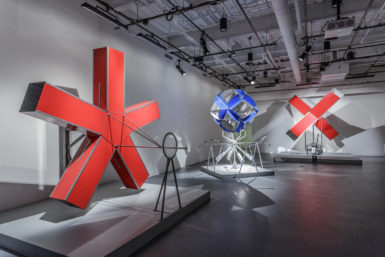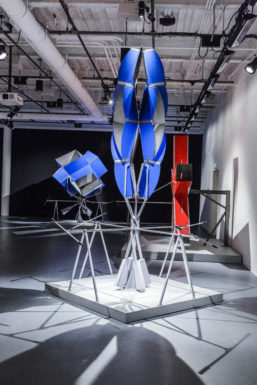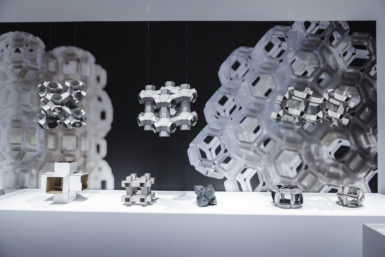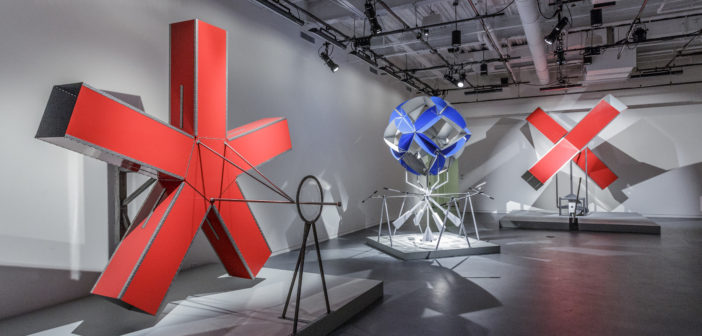Chuck Hoberman is an artist, designer, and engineer. He founded the multidisciplinary firm Hoberman Associates, is a member of the Wyss Institute for Biologically Inspired Engineering, and is one of the inaugural faculty members of the Harvard Graduate School of Design’s new Masters in Design Engineering (MDE) program. Currently his exhibition 10° is on view at Le Laboratoire in Cambridge.
Megan Gregory: Judging from your work thus far, it seems like transformation is a very important theme and inspiration. What is it about transformation that interests you?
Chuck Hoberman: Well, you might also ask, “What‘s not interesting about transformation?” It is an intrinsically fascinating concept. Everything in our lives can change. At the same time, transformation is surprisingly elusive to define, and more importantly from my perspective, to design or shape.
MG: In addition to physical and virtual materials from projects throughout your career, you created several large-scale kinetic objects that viewers can interact with for the 10° exhibition. Do you consider these large structures to be artworks, or are they more closely related to the design and engineering materials they are presented with?

Chuck Hoberman. 10°. Courtesy of Le Laboratoire. Photos by John Kennard.
CH: I see them as sculptures. They draw on ideas I had about movement and kinetics when I studied sculpture at the Cooper Union. Along the way, a lot of different ideas and opportunities took me in many different directions, but I always continued to make art.
One of the aspirations that I had when creating 10° was to broaden the range of sensory experience that art can provide. The shapes, colors, and materials of the sculptures are important considerations, but it’s the way the viewer’s body interacts with the sculpture itself that I believe represents the truly original aspect of this work. 10° is an experiment that utilizes precision engineering and mathematics to hopefully achieve something that is not quantifiable. The result is something that has certainly surprised me.
MG: In your practice, are art and design one and the same? Are those sorts of distinctions something that you focus on?
CH: There are a lot of practical issues around what something is called. I think that these sort of category questions–whether something is art, or design, or architecture–are really about context. Who is asking for it? Where is it going? How would people see it? There is something about that context which will lead them to emphasize one sector over another.
Of course, it’s interesting to make things that blur these boundaries, and I think the work in 10° does that. It’s not particularly something that I strive for; it’s almost a side product. These things refract in different ways conceptually. They touch on research in robotics and materials and architecture. One of the most exciting implications for me is in connection with new kinds of transformable materials. 10° is an artistic endeavor, yet incorporates a high level of precision engineering. I have a fantastic team who do the detailed engineering, working on the componentry, the fabrication, and the assembly and sequencing. The engineering is woven into the overall development.

Chuck Hoberman, 10°. Courtesy of Le Laboratoire. Photos by John Kennard.
MG: Why did you create Hoberman Associates?
CH: It’s a common story among creative people in design-related fields that you can’t always expect to be hired to create what is inspiring to you. So you become an entrepreneur. I’ve always been very motivated to build. I felt that the point is to launch beautiful and useful things into the world. So, I formed a company to realize and implement my ideas.
MG: I read in one interview that you described yourself as being a frustrated engineer in art school and a frustrated artist in engineering school.[i]
CH: Yes, that is quite true. In art school I was starting to take on this kinetic work without really having the skillset to implement it as well as I had hoped. That was when I was a frustrated engineer. In engineering school, I was swamped with catching up with all the physics and math that I needed to acquire and I didn’t have much time to pursue my original creative ideas. But it was great. It was exactly the educational experience that I wanted.
MG: Do you think that the attitude toward kinetic art has shifted in your experience with the art world?
CH: I can’t say that I know the answer to that question. My work has probably been a bit tangential to the art world in the sense that you are talking about it. I’ve shown several times at art museums like the Museum of Modern Art and the Centre Pompidou, but usually under the umbrella of the design department or the architecture department of those museums. In terms of where the collectors and galleries and art museums tend to focus, kinetic art does not appear to be the most respected category. There is something very functional about it and perhaps it’s just overly accessible.
I believe that kinetic art is not just a one-liner. Kinetic work engages the full sensory spectrum. It involves proprioception–the faculty of how we feel our bodies oriented in space and the way that fades into the tactile and the cognitive. It’s a very rich area and one that I think is underexplored. It is a given that the mind and the body are not separate, something that’s true both artistically and scientifically. I am finding my own ways to reaffirm that essential connection.
MG: What are you interested in working on in the future?
CH: I’m fortunate because I have the luxury to pursue projects and research that are interesting to me. The idea of transformation is still kind of the North Star for my creative work. I want to continue to make physical objects that transform in different ways to achieve experiences and that solve different functional problems. Perhaps this approach may even lead to some scientific discoveries.
Going back to the concept of transformable metamaterials that I mentioned earlier, in 10° we also show crystalline lattice structures that are capable of transformation. Working with my collaborators at Harvard, we are exploring how to exponentially increase the number of units within a structure while shrinking individual units down further and further. They all blend together and you’re left with a material that transforms itself as you handle a seemingly integral object.

Chuck Hoberman. Courtesy of Le Laboratoire. Photos by John Kennard.
MG: You’re currently on the faculty of the Harvard Graduate School of Design, and you have taught at Harvard for about five years. How does teaching influence your work? Does it change how you approach questions or ideas?
CH: Certainly. I’m coming to teaching after a number of years devoted to my practice. It is extremely exciting to see how new generations of artists, designers, and engineers approach problems that have fascinated me for decades. Young people bring fresh perspectives based on using a range of new parametric design tools that blur the difference between design and programming. I find this helpful to keep my own eyes fresh.
Beyond that, it’s a way to give back. I’ve had the good fortune to be a pioneer in this area of transformable design. It’s great to share my experience with people who will take it to a new level.
[i] Tom Waters, “The Unfolding World of Chuck Hoberman,” Discover Magazine (March 1992): http://discovermagazine.com/1992/mar/theunfoldingworl6.


1 Comment
Great Interview thank you for sharing!